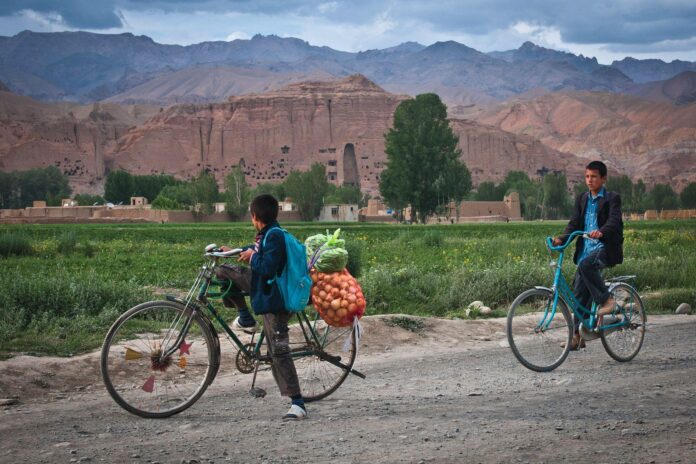A multimillion-dollar Italian funded Unesco project in Bamiyan has resumed after it was abruptly placed on hold when the Taliban took control of Afghanistan in August 2021.
In November 2022 cultural heritage experts from around the world gathered at a conference in Florence, with the key objective of exchanging ideas on how to tackle the challenge of preserving Afghanistan’s vulnerable heritage sites as the country remains isolated by strict sanctions and a government widely unrecognised internationally. Particular focus was placed on the Bamiyan Valley, whose cultural landscape and archaeological remains were placed on Unesco’s World Heritage in Danger list in 2003.
The conference, which was organised by Florence University and the Italian Agency for Development Cooperation (AICS), ended with an unexpected, but welcome, announcement by the Italian foreign ministry to review its funding commitment to Bamiyan. The government approved the budget in the new year and the scheme relaunched in late February.
The project has several goals including conservation works at several Unesco World Heritage sites in Bamiyan as well as implementing infrastructure to improve safety on sites, boost potential visitor experience and develop a conservation management plan. The Bamiyan cliffs and Shahr-e Gholghola, a sixth- to tenth-century citadel, are at the heart of the project, both of which are in desperate need of intervention. The works are expected to provide much needed humanitarian relief in the form of employment for around 100 locals who are currently experiencing one of the worst humanitarian crises in the world.
“In addition to generating income, the aim is to develop skills that will put [local people] in a better position to seek future livelihood and employment, as well as through addressing the long-term sustainability of the World Heritage property, which will be a source of employment for generations to come, if protected and managed appropriately,” a Unesco spokesperson tells The Art Newspaper.
Most foreign investment and projects were halted after the Taliban takeover of the country, due to investors’ fears of unintentionally breaking the sanctions imposed on the country. As a result, Afghanistan’s economy has crumbled and it has been isolated from much of the outside world, especially from the West. Although Unesco and private foundations have continued with some heritage projects in the country, Italy’s decision to restart the Bamiyan project is thought to make it the first country to approve funding in the field of conservation in Afghanistan.
“First of all, this decision helps safeguard the [country’s] heritage. Secondly, it introduces some economic stimuli with potential consequences in terms of tourist development, especially from China. Third, politically the decision facilitates a sort of dialogue with the local authorities: elementary communication is better than none,” says Mirella Loda, the project coordinator for Bamiyan’s strategic master plan and one of the organisers of the Florence conference.
Loda says restarting the project will ensure that the past 20 years of engagement and expenditure have continuity while creating the opportunity to reach the more moderate voices among the country’s new rulers.
“Indirectly, actions like this support the forces interested in reducing the isolation of the local society from the rest of the world,” Loda says.
Mawlawi Saifurrahman Mohammadi, the Taliban’s director of ministry for information and culture for Bamiyan, says his government has done everything it can to protect and secure Bamiyan and other heritage sites across the country but stresses it needs international support to do the job.
“We don’t mind if it is Unesco or any other international organisation that wants to come and help preserve our heritage sites—the most important issue for us is that these sites are safeguarded,” Mohammadi says. “Without a doubt, heritage preservation projects will have a positive impact on the social and economic situation of people in Afghanistan and we support them,” he adds.
Bamiyan’s Buddha statues
On 11 March 2001 the Taliban destroyed Bamiyan’s monumental sixth- and seventh-century Buddha statues. Although the group has never publicly expressed regret for its actions, the ministry of information and culture has marked 11 March Cultural Heritage Preservation Day and even held an event this year in Kabul’s National Museum of Afghanistan at which officials stressed the importance of safeguarding all heritage sites, including pre-Islamic ones.
“Bamiyan is important not only for its precious heritage but also for its symbolic meaning: it represents the worst face of Taliban power as it was displayed in 2001. Convincing the new rulers to safeguard Bamiyan’s heritage is equal to measuring the distance between the Taliban today and that of 2001,” Loda says.
Unesco says that, while it continues to operate in the country, it is “deeply concerned” about the situation in Afghanistan and only works within the boundaries of the Transitional Engagement Framework (TEF), a comprehensive planning document for the UN’s assistance in the country. The plan prioritises humanitarian assistance and supports the preservation of cultural sites but limits engagement and acts of recognition of the current government.
In Afghanistan, Unesco currently has projects in Jam, in the west of the country, funded by the Swiss-based Aliph foundation (International Alliance for the Protection of Heritage in Conflict Areas foundation); and in Bamiyan, funded by Italy and Japan. It is also active in the emergency protection and conservation of sites in Zabul, Kandahar, Ghazni and Kabul through Unesco’s Heritage Emergency Fund.
Unesco is further implementing a water management programme in collaboration with the UN Food and Agriculture Organisation aimed at rehabilitating traditional canal systems in Samangan and Zabul.
“This activity has an important intangible cultural heritage component as these systems have been developed, managed and maintained through generations of knowledge passed down through hundreds of years. This knowledge and other aspects of intangible heritage are at risk of being lost if not documented and supported,” Unesco says.
Unesco’s current projects in Afghanistan provide employment for around 80 people in Jam, 60 in Samangan and 60 in Zabul.

























